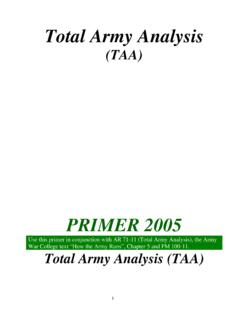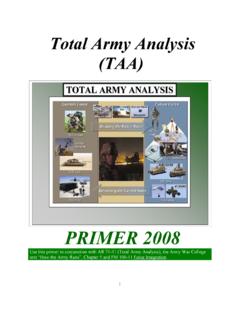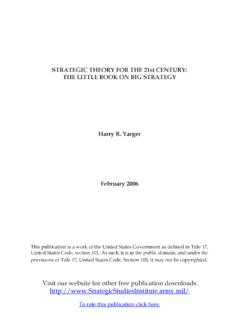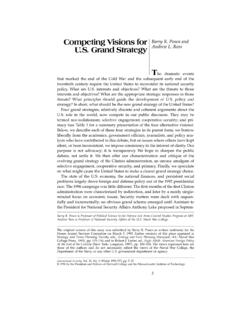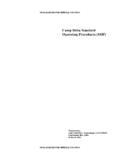Transcription of Total Army Analysis (TAA) - comw.org
1 Total army Analysis (TAA) PRIMER 2008 Use this primer in conjunction with AR 71-11 ( Total army Analysis ), the army War College text How the army Runs , Chapter 5 and FM 100-11 Force TAA 1 Total army ANALYSISTOTAL army ANALYSIS1 Total army Analysis (TAA) I. Force Development Process (overview)1. The focus of this primer is the Total army Analysis process. In order to understand the TAA process, it is imperative that a person understand of where TAA fits into the larger process which is called Force Use this primer to supplement information provided in the army War College text How the army Runs , FM 100-11 Force Integration, and army Regulation 71-11 Total army Analysis . 3. Force development is the start point, rationale and underlying basis for defining the army s force structure.
2 The Force Development Process consists of defining military capabilities, designing force structures to provide these capabilities, and translating organizational concepts based on the threat, doctrine, technologies, materiel, manpower requirements, and limited resources into a trained and ready army . The five phases are:a. Develop Capabilitiesb. Design Organizationsc. Develop Organizational Modelsd. Determine Organizational Authorizationse. Document Organizational Authorizations4. The five phases of the force development process are displayed at figure 1. This model reflects a sequence of events and how these functions relate to each other. The resulting products of force development provide the basis for acquiring and distributing materiel and acquiring, training, and distributing personnel in the army .
3 It is useful to use the army Force Development Process to visualize how each step relates to the other steps and contributes to the accomplishment of each task. Figure 12 Acronym list for figure 1: ARSTRUC: army Structure MessageASCC: army Service Component CommandBOIP: Basis of Issue PlanBOIPFD: BOIP Feeder DataCCP: Concept Capability PlanCDD: Capability Development Document DLMP: Doctrine & Literature Master PlanDRU: Direct Reporting UnitFDU: Force Design UpdateFMS: Force Management System G-37(FM): Force ManagementIPL: Integrated Priority ListLOGSACS: Logistics SACsMDEP: Management Decision PackageOI: Organization IntegratorOPFAC: Operational Facilities PBG.
4 Program Budget GuidancePERSACS: Personnel SACSSACS: Structure and Composition SystemSAT: Systems Approach to TrainingTAA: Total army AnalysisTAADS: The army Authorization Documentation SystemTOE: Table of Organization and EquipmentTRAS: Training Requirements Analysis SystemUIC: Unit Identification CodeURS: Unit Reference SheetUSAFMSA: Unite States army Force Management Support AgencyUSASOC: army Special Operations Commanda. Develop capabilities. 1)The force development process has its roots in the Joint Capabilities Integration and Development System (JCIDS). A separate primer (Capabilities Development and Systems Acquisition Management), discussing the JCIDS process, can be found on the army Force Management School web site.
5 JCIDS identifies the desired operational capability in terms of personnel, equipment, and unit structure. This process begins with the receipt of strategic / national-level guidance [National Security Strategy (NSS), National Military Strategy (NMS), Quadrennial Defense Review (QDR), Guidance for Development of the Force (GDF), Joint Programming Guidance (JPG), and guidance from the army s senior leadership (The army Plan (TAP))], joint warfighting concepts (such as rapid decisive operations and peace enforcement operations), and/or new materiel capabilities evolving from research, development, and acquisition (RDA) )The focus of JCIDS is to resolve identified capabilities gaps, perceived deficiencies and / or shortcomings in the joint force.
6 The objective of JCIDS is to develop solutions that are affordable, militarily useful, and supportable to the combatant commanders. JCIDS develops integrated, joint capable solutions within the domains of DOTMLPF (doctrine, organizational structure, training, materiel, leadership and education, personnel and facilities). The process examines where we are, where we want to be, what risks we may face and what it might )The Analysis process is composed of a structured, three-phased capabilities-based assessment (CBA) methodology that identifies tasks, determines capability gaps and redundancies, and proposed DOTMLPF approaches to resolve or mitigate validated capability gaps. army Training and Doctrine Command (TRADOC) army Capabilities Integration Center (ARCIC) assesses the future warfighting concepts through a series of analyses, tests, experiments and studies to gain insights across DOTMLPF.
7 Using the integrated capabilities development teams (ICDT) management technique, TRADOC pursues timely involvement of appropriate agencies/expertise to aggressively identify and work issues. TRADOC establishes force operating capabilities (FOCs) as the foundation upon which to base the assessment process. These critical, force-level, measurable statements of operational capability frame how the army will realize advanced full spectrum operations as stated in the approved capstone concept. The FOCs focus the army s Science and Technology Master Plan (ASTMP) 3and warfighting experimentation. As the transformation process unfolds, these force-level objective concepts give rise to supporting proponent/branch future FOCs included within subordinate concepts.
8 This assessment process leads to a recommendation by the Commanding General (CG), TRADOC to Headquarters, Department of the army (HQDA) on how to best fulfill the warfighting requirement. If the capability requires a change in doctrine, training, or leader development, TRADOC begins action to meet the requirement upon validation by the HQDA Deputy Chief of Staff (DCS), G-3/5/7 and approval by the Chief of Staff, army (CSA). If the solution set results in a need for change in soldier occupational specialty structure, the recommendation goes forward to HQDA DCS, G-1 for action. If the required capability needs a materiel solution, TRADOC prepares the initial capabilities document (ICD) and a capability development document (CDD).
9 TRADOC forwards the ICD and CDD to HQDA DCS, G-3/5/7 for approval of the requirement through the army Requirements Oversight Council (AROC) validation/approval process. HQDA DCS, G-8 is responsible for materiel solutions and DOTMLPF integration throughout the program life cycle. Warfighting concepts requiring organizational solutions move to the next phase of force Design organizations. 1)The DESIGN ORGANIZATIONS PHASE provides the organizational solution to DOTMLPF. This Phase analyzes the proposed organization or change to an organization for doctrinal correctness. This phase provides a forum for the entire army to review the issue while linking the Capability, Materiel, Training and Document Developers together.
10 Organizational requirements flowing from the Functional Solution Analysis (FSA), determine whether a new or modified organization is required on tomorrow s battlefield to satisfy the capability gap identified in the DEVELOP CAPABILITIES PHASE. Organizational requirements are documented through a series of connected and related organizational development processes: Unit Reference Sheet (URS) development; Force Design Update (FDU) process; Table of Organization and Equipment (TOE) development; and Basis-Of-Issue Plan (BOIP) )When a DOTMLPF Analysis is performed, and a new or improved organization is selected as the best solution, the capability development communities in TRADOC or the other proponents document proposed organizations or modifications to existing organizations on a unit reference sheet (URS).
